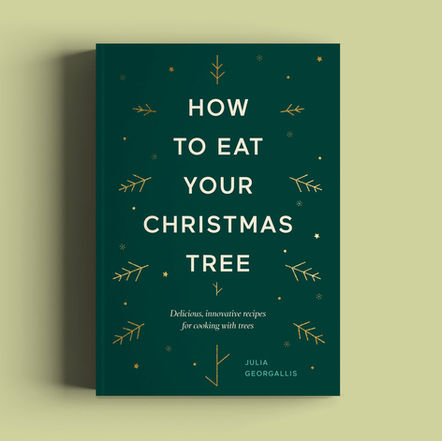
The ‘How to eat your Christmas tree’ project is a cookbook and supper club series by
Julia Georgallis that explore the unsung edible heroes of our forests— Christmas trees and their delicious, evergreen friends! Both book and supper club encourage reflection around food waste and resourcefulness during Christmas, one of the most wasteful times of year. Trying to eat your tree is not only a way of extending the already short shelf life of something that has become so inappropriately disposable but is also an opportunity to really scrutinise keeping trees in the first place. The cookbook offers ways of cooking with Christmas trees, Christmas tree alternatives and can also be used as a handbook for a more sustainable festive period.
The project began in winter 2015 as a light-hearted dinner club before climate change had become one of the world’s primary concerns. The supper club continued each festive season and has gained more and more interest as the noise surrounding climate change has increased. Just before the Covid-19 pandemic, recipes from the dinners were collated and turned into a cookbook, funded via crowdfunding. The book was then published by Hardie Grant and has since sold thousands of copies worldwide, appeared in a number of TV and radio programmes, print, online articles and podcasts. It has now been translated into French and German. The last series of supper clubs ran in early 2023.
Though there's no doubt that eating a Christmas tree won't singlehandedly help any polar bears or freeze any icecaps but doing so is an example of how reuse and re-appropriation could help, even in a small way, in the global fight against climate change. The aim of the project is to start a conversation about why on earth we still insist on cutting down trees that usually live a really long time (literally thousands of years) to keep in our homes as ornaments for 6 weeks. Feasting on our trees is celebratory and connects us back to the land. By eating them rather than throwing them out once Christmas is done and dusted, we are not only repurposing them, but are acknowledging them as living things instead of simply commodities of Christmas. If we are going to cut down a tree that works to protect our environment, we would do much better to think about how we can use it to its fullest potential, not just stuff it down the back of the bin on a cold January morning. It also throws into question whether we can use other trees that may be better for the environment to celebrate Christmas (such as bamboo, a much faster growing and more sustainable plant, or adorn our house plants instead?).
























